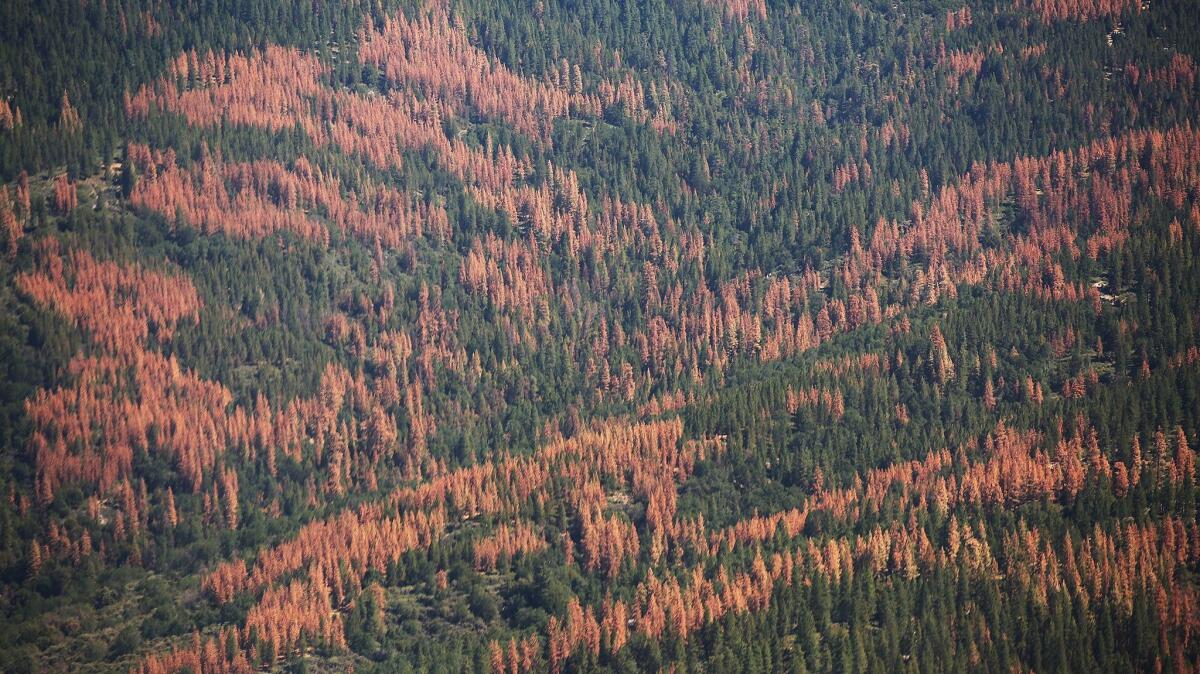Op-Ed: A beneficial way to dispose of the Sierra’s lost trees: Use them for energy

- Share via
When the Forest Service announced its calculation last November that the Sierra Nevada contained 102 million dead trees, it conveyed the immensity of a tragedy that is unprecedented in California’s history. It also challenged planners and innovators to find a beneficial use for at least some of the dead trees. As it turns out, there is one.
The direct cause of the die-off is an infestation of native bark beetles, but the beetle population would not have exploded without California’s five-year drought and a longstanding policy of fire suppression, which has crowded the forests with weak, sunlight-and-moisture-starved trees. More than 500,000 dead trees were removed last year, but the rest stand in place, as straight as birthday candles, which they can rival in flammability. If lightning or a camper’s carelessness causes them to ignite, the result could be one more calamitous conflagration to add to the state’s recent string of them.
This is worrisome for many reasons. Catastrophic fires don’t stimulate regrowth, as lesser fires do: The hotter temperatures they generate scorch the landscape and destroy the seeds needed for plant regeneration. That leads to severe soil erosion, landslides and devastated wildlife. Megafires also blanket large areas of the state with sooty black carbon, which is toxic to humans and a notorious climate pollutant, with a global warming potential 3,200 times more potent than carbon dioxide.
In recent years, a few innovative small companies have developed ways of producing energy from the dead trees in an environmentally sound way.
Even in the absence of fire, dead and dying trees are dangerous. They fall on roads, homes, buildings, transmission lines and people, sometimes with mortal consequences. For this reason Gov. Jerry Brown issued an emergency proclamation in October 2015 to clear the trees from high hazard zones. Stacks of beetle-bored timber are now piled up beside roads and in empty lots and at government facilities.
A better approach would convert the dead trees into energy. In the early 1990s California had as many as 66 large power plants that produced electricity from wood and agricultural waste, but more than half of them closed when government price supports expired. In any case, the technology, which uses combustion, is problematic: Burning tree waste produces substantial greenhouse gas emissions, and transporting the waste to faraway plants adds still more emissions and increases the cost. To meet the dead tree emergency, some plants’ contracts are now being renewed, but the technology’s drawbacks limit its appeal.
However, in recent years, a few innovative small companies have developed ways of producing energy from the dead trees in an environmentally sound way. These methods, said Arne Jacobson, director of the Schatz Energy Research center at Humboldt State University, are “not going to completely solve the 100-million-dead-tree problem immediately, but they’re something we should be looking at as part of the solution on a 5- to 20-year time scale.”
One of the most promising technologies, deployed by Berkeley-based All Power Labs, produces electricity through gasification, which is more efficient and environmentally benign than combustion. Equally compelling, the company’s “power plant” units are small enough to fit inside a shipping container, which can be towed by truck to the hazard zones, reducing transport costs and greenhouse gas emissions.
Aside from their main output, electricity (which can be fed into the grid), the units generate a key byproduct, biochar, a charcoal-like substance that is almost pure carbon. When applied to soil, biochar stimulates plant growth and reduces water consumption, which makes it a valuable commodity in water-stressed California fields. In essence, biochar is carbon that would otherwise have been released into the atmosphere, which makes All Power’s gasification process not just carbon neutral but carbon negative.
All this ought to place such new technologies at the forefront of efforts to remove the high-hazard trees, particularly because the trees can be used to generate electricity only for a decade, at most, before decomposition renders them useless. Brown’s proclamation instructed the California Public Utilities Commission to expedite contracts with bioenergy companies, yet no contracts have been signed.
One reason the PUC is hesitating is that absent economies of scale, the cost of the electricity generated by the new technologies is several cents-per-kilowatt-hour higher than that of other renewable energy sources. The PUC thus must weigh their benefits of reducing fire risks and climate change against the added cost to utility ratepayers. And while power companies could help foster this new energy source, according to the PUC and All Power, they have instead acted chiefly as obstacles because they don’t profit from the technologies’ spread.
The technologies’ greatest asset — carbon negativity — should tilt regulators in their favor. After all, unchecked climate change will end up costing Californians far more than the modest increase that utility ratepayers would be asked to pay. For now, the state is stuck in a vicious circle: Climate change caused or intensified the drought, which brought on the tree die-off, which accelerates climate change. Unless climate change is tamed, the current die-off will be far from the last.
Jacques Leslie is a contributing writer to Opinion and the author of “Deep Water: The Epic Struggle Over Dams, Displaced People, and the Environment.”
Follow the Opinion section on Twitter @latimesopinion and Facebook
MORE FROM OPINION
Is there such a thing as good eugenics?
A transgender child’s dilemma: When to go, and where
Why school should start later in the day
More to Read
A cure for the common opinion
Get thought-provoking perspectives with our weekly newsletter.
You may occasionally receive promotional content from the Los Angeles Times.









